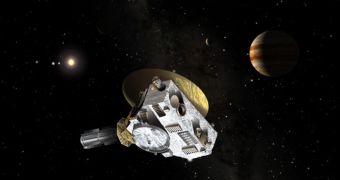According to officials at the American space agency, the New Horizons space probe is currently being prepared for yet another important milestone in tis mission, its flyby of the gas giant Uranus.
The event will take place on March 2011, as the spacecraft heads towards Pluto at a speed of nearly 36,000 miles per hour (nearly 58,000 kilometers per hour). The probe left Earth in 2006.
It is currently scheduled to reach the distant dwarf planet by July 25. It has already covered more than half the 3 billion-mile (4.8 billion-kilometers) distance it needs to travel to get there, and is currently a lot closer to Pluto than it is to the Sun.
Speaking of which, NASA officials report that the probe is about 18.5 astronomical units (AU) away from the star. An AU is equal to the mean distance between our planet and the Sun, or 93 million miles.
Once New Horizons reaches Pluto and the Kuiper Belt, it will focus its attention on the dwarf planet itself, as well as on its three moons, Nix, Hydra and Charon. Currently, we only know these objects from computer models.
Not even the Hubble is able to snap clear images of the objects' surfaces, and astronomers are really curios about what secrets they may hold. Studies of other large Kuiper Belt objects, such as the dwarf planet Eris, are also being considered.
Among the most interesting events that may be going on on Pluto, experts include the apparent geyser eruptions telescopes hinted at, as well as the seasonal color changes the dwarf planet's surface exhibits.
“These discoveries have helped develop our encounter with Pluto, which is now fully planned,” explains Southwest Research Institute (SwRI) expert and New Horizons principal investigator Alan Stern, quoted by Space.
“We have a list of things of do, which has been converted into a timeline of events, which has been converted into spacecraft software with all the commands to run the spacecraft and instruments,” the scientist goes on to say.
This particular space probe “is very different from most missions in the solar system today. It's like we're back at the early days of planetary exploration,” the investigator adds.
The mission is the first to address a dwarf planet or the Kuiper Belt. It is also the first to look at a new type of planet since the missions conducted to Jupiter in the 1970s.
“So we don't have a narrow scope here – we're going to write the book on Pluto and the dwarf planets,” Stern explains.
“We're here to map Pluto, map its surface composition, measure its atmospheric composition, pressure and temperature and assay the same kinds of measurements for all of its satellites,” he concludes.

 14 DAY TRIAL //
14 DAY TRIAL //